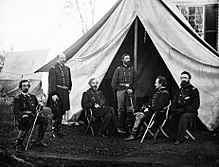George Sykes
George Sykes (born October 9, 1822 in Dover , Delaware ; † February 8, 1880 at Fort Brown, Texas ) was an officer in the US Army and general during the American Civil War .
Before the civil war
Sykes was the son of Governor James Sykes (1761-1822) and grandson of James Sykes Sr. who had represented the State of Delaware in the Continental Congress . He graduated from the Military Academy at West Point , New York, in 1842 and was awarded the rank of lieutenant in the 3rd US Infantry Regiment . He served in the Mexican-American and Seminole Wars . Through his services at the Battle of Cerro Gordo on April 18, 1847, he received the brevet rank of captain .
In the civil war
When the American Civil War broke out, Sykes was assigned to the 14th Infantry Regiment as a major . At the First Battle of Bull Run , he commanded a regular infantry battalion made up of eight regular companies from various regular regiments. These were the only regular soldiers on the battlefield. He also led an association of regular soldiers in the early defense positions around Washington, DC and as a division commander in the Peninsula Campaign , he led the 2nd Division of the V Corps . His soldiers, who referred to themselves as "Sykes 'Regulars", held their positions at Gaines' Mill during the seven-day battle when the Union lines broke elsewhere.
Sykes took part as division commander in the Second Battle of the Bull Run and the battles of Antietam (in reserve) and Fredericksburg . After the Battle of Antietam on November 29, 1862, Sykes was promoted to major general. At the beginning of the Battle of Chancellorsville , his regulars led the advance into the Confederate rearguard . When they met strong resistance there, the Commander-in-Chief of the Potomac Army , Major General Joseph Hooker , ordered the commanding general of the III. Corps to stop the attack. As a result, Sykes' men were no longer used for the remainder of the campaign. In none of these battles did he demonstrate any aggressive or unique offensive capabilities on his part. He was known to his comrades by the nicknames "Tardy George" and "Slow Trot" Sykes. When the commanding general of V Corps, Major General George G. Meade , was appointed Commander in Chief of the Potomac Army on June 28, 1863, Sykes assumed command of V Corps.

At the Battle of Gettysburg , Sykes' Corps supported the III. Corps on the left flank of the Union. In the 1st Division, led by Brigadier General James Barnes , Colonel Strong Vincent's brigade defended the Little Round Top with the 20th Maine Infantry Regiment under Colonel Joshua L. Chamberlain . Meanwhile, the 3rd Division, the Pennsylvania Reserves under Brigadier General Samuel W. Crawford , attacked the Confederates from the Little Round Top and drove them to the "Valley of Death", where fatal fighting broke out in Wheatfield . However, there is little to be found in the historical account of Sykes' personal involvement.
During the Mine Run campaign in the fall of 1863, Meade complained about Sykes' lackluster appearance. Meade and Army Commander in Chief Ulysses S. Grant agreed that Sykes was not well prepared for the upcoming overland campaign in May 1864, so Sykes had to relinquish command of V Corps when the Potomac Army was reorganized and became commander in the Kansas Military District. During Price's Raid in 1864 he was replaced by James G. Blunt .
After the civil war
After the war, Sykes received the rank of lieutenant colonel in the regular army. He served in the 5th and as the commander of the 20th U.S. Infantry Regiment. Until his death in 1880, Sykes served on the former Frontier from Minnesota to Texas. He was buried in the West Point Military Academy cemetery.
literature
- Eicher, John H., and Eicher, David J., Civil War High Commands , Stanford University Press, 2001, ISBN 0-8047-3641-3 .
- Tagg, Larry, The Generals of Gettysburg , Savas Publishing, 1998, ISBN 1-882810-30-9 .
- Warner, Ezra J., Generals in Blue: Lives of the Union Commanders , Louisiana State University Press, 1964, ISBN 0-8071-0822-7 .
Web links
- George Sykes in the database of Find a Grave (English)
- Civil War Biographies: George Sykes
- Sykes' regulars
Individual evidence
| personal data | |
|---|---|
| SURNAME | Sykes, George |
| BRIEF DESCRIPTION | General of the US Army |
| DATE OF BIRTH | October 9, 1822 |
| PLACE OF BIRTH | Dover , Delaware |
| DATE OF DEATH | February 8, 1880 |
| Place of death | near Fort Brown, Texas |

